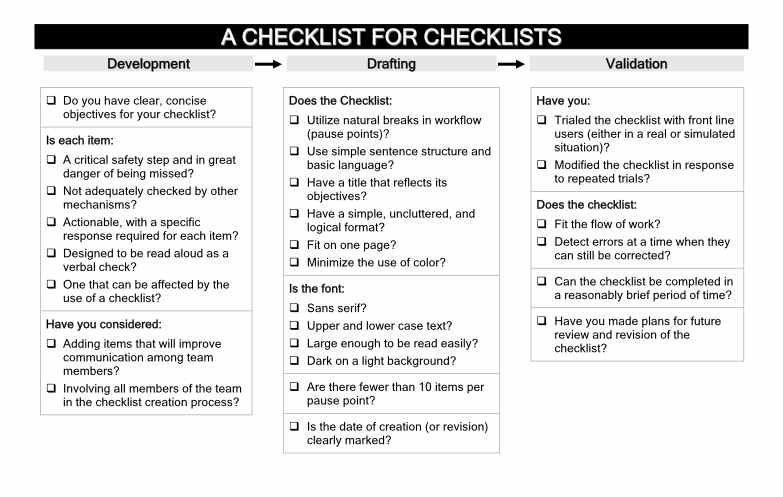Checklist Simplicity
Our work shipping effective, creative, and simple learning content is inherently complex. Checklists help.
They allow experienced surgeons, and pilots, do their best work without errors. And they’re perfect for learning design, which can be a messy process.
Most of the concepts below derive from Atul Gawande’s excellent book, The Checklist Manifesto.
He talks about two kinds of checklists, READ-DO and DO-CONFIRM.
As you’d expect from their names, when using the READ-DO checklist, you read each item on the list first, complete the task, and cross it off. When using the DO-CONFIRM checklist, you would complete all the tasks first, then go back to see if you missed anything.
When creating internal checklists for a learning team, creating READ-DO lists is the preferred way. After the team member is familiar with the tasks, she may start using the checklist as a DO-CONFIRM list.
The above image is from Gawande’s book. Note that this is actually three checklists, each of which is a DO-CONFIRM list intended to be completed at the end of a particular phase.
When creating internal checklists for a learning team, I typically create DO-CONFIRM lists built for the more experienced designers. Then I add in optional (and hideable) scaffolding for the newer people.
Big Idea
People adopt checklists when they're valuable and easy to use.
The only reason to deploy checklists is to make someone’s job easier to perform without errors. That’s it, full stop.
A lens for deciding:
Will this checklist lead to a positive learner experience?
Is this checklist thorough without being tedious?
Key Concepts
Checklists reduce errors while also lowering stress.
Executed well, checklist-based processes declutter our brains, relieve our dependence on memory, and allow team members to focus on the creative parts of a project.
Often, team members lose valuable time getting started. A checklist can “jump start” the initital phase.
Later on, the project waits for folks to be available for meetings and sign-offs. Well-designed checklists allow people to work on other important elements during a pause for reviews.
There is life beyond checklists.
Not everything belongs in a checklist. Attempts to force everything into a checklist will make everyone grumpy.
If you’re developing a script for a video, write the script in whatever way works best for you. After completing the script, use the Video Script Checklist to ensure you’re on the right track.
There is no checklist for "Quality".
Checklists are great for ensuring nothing gets missed and the requirements of the project are met.
A checklist won’t evaluate the clarity of your writing, or whether another activity might be more effective than the one you’ve included.
Evaluating for quality generally requires implementing rubrics, which I’ll talk about elsewhere.
The Review process must be aligned with the Design process.
Wouldn’t be fair otherwise, would it?
When reviews are lined up with the rest of the process, people people are free to do their best work, feeling safe.
Checklists are intended to support quality work, not catch people making errors.
Getting Started
This one is straightforward.
Put Learners First will provide robust checklists and other process materials that should get you 80% of the way. Your team will want to add in the 20% to customize them for your team.
As soon as they’re ready, use them.
Include a Checklist Suggestions link so people can log potential changes as they go. Even after you get the initial bugs out, expect to improve the lists over time.

